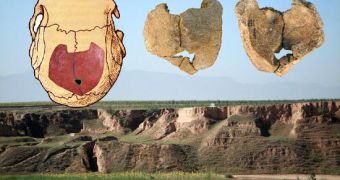Fossil evidence recently uncovered in northern China suggests that early humans were no strangers to inbreeding, hence some individuals' displaying various physical abnormalities.
The researchers now stating that said practice was fairly common amongst early people base their claims on their analysis of a skull unearthed at Xujiayao, in China's Nihewan Basin.
This skull is believed to be at least 100,000 years old, and shows clear signs of having had its normal development patterns disrupted by a congenital deformation which presently manifests itself in one out of every 25,000 human births. EurekAlert informs us that the congenital deformation pinned down by the specialists who took the time to analyze the so-called Xujiayao 11 skull basically refers to the fact that the individual displayed a perforation through the top of his brain case.
This “hole in the skull,” as some researchers refer to it, is believed to be the direct result of a rare genetic mutation which keeps the back of an individual's prenatal brain case from becoming holes-free during their first five months as a fetus.
The same source reports that this particular skull is not the first to indicate that early humans were affected by said congenital deformation quite often.
Commenting on these findings, study co-author Erik Trinkaus, a specialist currently working with the Washington University in St. Louis, made the following observations:
“The probability of finding one of these abnormalities in the small available sample of human fossils is very low, and the cumulative probability of finding so many is exceedingly small.”
“The presence of the Xujiayao and other Pleistocene human abnormalities therefore suggests unusual population dynamics, most likely from high levels of inbreeding and local population instability,” Erik Trinkaus went on to argue.
A detailed report of this research into the Xujiayao 11 and its findings was published in the scientific journal PLOS ONE this past March 18.

 14 DAY TRIAL //
14 DAY TRIAL //